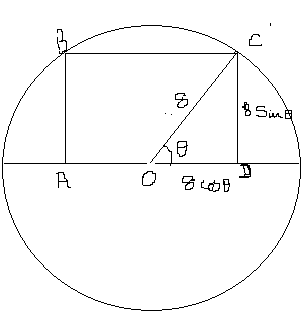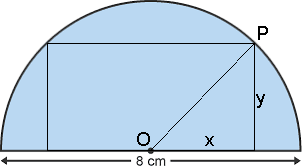Question #494b1
3 Answers
Explanation:
Consider the x and y coordinates of the triangle in the first quadrant of the semi circle. The length of the required rectangle will be
So the area of the rectangle required would be
We know from trig and the equation of a circle that
Since the radius is
Let a =area, and now differentiate a with respect to theta using the product rule.
Remember
,
so the area of the rectangle is
One could also take the second derivative to see if it is negative but is not needed here, I believe,............[it is]. Hope this helps.
"Area " = 64 \ cm^2
Explanation:
We consider a rectangle inscribed in a semicircle of radius
Let us set up the following variables:
{ (x,"semi-width of the rectangle", cm), (y, "height of the rectangle ", cm), (A, "Area of the rectangle ", cm^2) :}
Our aim is to find an area function,
The Area of the rectangle is given by:
A = "width" xx "height"
\ \ \ = (2x)(y)
\ \ \ = 2xy ..... [A}
Using Pythagoras we have:
OP^2 = x^2 + y^2
:. 8^2 = x^2 + y^2
:. y^2 = 64 - x^2
We could substitute for
A = 2xsqrt(64 - x^2) ..... [B]
However, we can get a cleaner solution by considering
A^2 = 4x^2y^2
\ \ \ \ = 4x^2(64 - x^2)
\ \ \ \ = 256x^2-4x^4
Differentiating (Implicitly) wrt
2A (dA)/dx = 512x-16x^3
At a critical point (a minimum or a maximum) we require that the derivative,
2A xx 0 = 512x-16x^3
:. 512x-16x^3 = 0
:. 16x(32-x^2) = 0
:. 32-x^2 = 0
:. x^2 = 32
:. x=+- 4 sqrt(2)
Obviously we require that
And, with this value of
A^2= 4x^2(64 - x^2)
\ \ \ \ = 4(32)(64-32)
\ \ \ \ = 4(32)(32)
\ \ \ \ = 2^2 \ (32^2)
And so,
A = (2)(32)=64 \ cm^2
We need to establish that this value of
graph{2xsqrt(64 - x^2) [-2, 10, -5, 70]}
And we can verify that a maximum when
Explanation:
In addition to the great answers already posted, here is another attempt for a simpler solution. Consider the figure drawn below, depicting a rectangle ABCD drawn in a semicircle of radius 8cm,with its centre O

Length Ad of the rectangle would be
Area of rectangle would be
This would be maximum when
This gives
The maximum area would thus be



